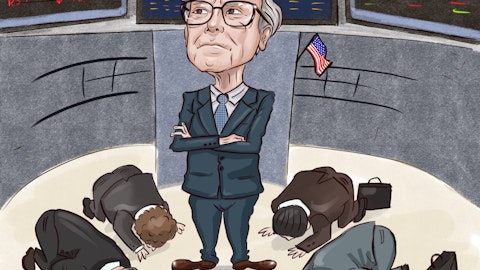Jon Jaffe: The target.
Diane Bessette: Target, yeah.
Susan Maklari: Okay. That’s very helpful. And maybe building on that a bit, you’ve obviously talked a lot about thinking of the cash generation of the business and converting net income to cash flows. As you think about the go-forward and the environment that we’re in and the increased agility in the business, what could that mean for cash generation next year? Any thoughts there?
Stuart Miller: Everything that we have done to reconfigure our business is focused on turning profitability into cash flow and making sure that we are generating a consistent level of cash coming in. And everything that we’re underwriting right now, even if margin moves up or down to some extent as a moderator for where sales or interest rates might go, our cash flow is still going to be very, very strong as we go forward.
Susan Maklari: Okay. Great. Thank you for the color, and good luck.
Stuart Miller: Okay. Thank you.
Operator: Next, we’ll go to the line of Stephen Kim from Evercore ISI. Please go ahead.
Stephen Kim: Yeah, thanks very much, guys. Appreciate all the color, and congrats on the results. I did want to touch on the — some of your longer-term comments. So first of all, not to get too granular, but in 2024, the closings number, we’ve observed that as cycle times have improved, you’ve been able to deliver more units or close more units than you’ve taken orders for. I was curious as you look into 2024, Diane, is it reasonable to think that you could likely close as many units as you take orders for? And then secondarily, you talked about — I think, Stuart, you talked about return on assets as being an important metric for you. Curious if you could give us a sense for longer term, where you target your ROA as you look — think about the business going forward?
Stuart Miller: Okay. So, we do think that as we sell, our delivery schedule is really tied pretty closely to — given the fact that we are not selling way out in front, it’s pretty much tied to how we’re selling and the current sales pace. And so you can look at that today and see our operating machine really working. Sales and starts and closings are all working in close proximity to one another. In terms of return on assets, Steve, which is a great question, we have the difficulty of an asset base that just because of strong earnings and strong cash, it becomes a tougher and tougher hurdle. Our focus is on return on assets closer to 20%. So, it gets harder to achieve as we keep adding earnings and asset base to the program.
And one could argue that we need to be buying back stock a little bit more aggressively. Diane and I talk about this all the time. And I’d say that we look at this opportunistically. Looks like today’s stock price is getting even more attractive. So it’s part of the program, but we are targeting in excess of a 20% return on assets.
Diane Bessette: Yes, I think that’s right, Steve. You have to kind of make it a little bit more granular, right, as we focus on turning our inventory, as we focus on reducing our years of owned. Those are all helpful components, of course, to return on assets. And if we pair that with a consistent buyback program, which we have been consistent, the amounts may vary quarter-to-quarter, but we have a pretty consistent program. And I think that all bodes well in us achieving something over 20% as time goes on.
Stephen Kim: Yes, that’s really helpful, and that’s kind of where I was going to go next. So I appreciate you anticipating that.
Stuart Miller: We saw you coming.
Stephen Kim: Next question I have — yeah, exactly. Next question I have relates to sort of market conditions and, in particular, the entry level of the market in light of the rate increase. So I would say — my question is, in general, would you say that the move-up segment right now is performing a little stronger than entry level? And at the entry level, when we think of rate buy-downs, like what percent of your sales are using a rate buy-down? And are you going into the market buying — making forward purchase commitments? And are you increasing the degree of rate buy-down relative to the prevailing rate? Or are you continuing to buy down that rate by about the same spread?
Stuart Miller: So, listen, as we’ve said, as rates move around, as demand moves around, we are tapping incentives up or down, we’re maintaining pace. But the fact is that we haven’t had to move dramatically in either direction as rates have moved currently. You asked whether it’s the entry-level buyer or the move-up buyer that is doing better, frankly, there’s strong demand across the platform. And in all segments, we are seeing strong demand out there. Affordability is kind of a question, and meeting the buyer where the affordability exists is kind of the trick of the market and getting it just right. And so, these are tweaks right now up and down. And of course, depending on where interest rates go, that is going to be the determinant of how much of an incentive has to be given or doesn’t have to be given. And that’s what we’re kind of working our way through right now as you go through pricing. Jon, could you add to that?
Jon Jaffe: Yeah. Steve, you asked the question. We do buy forward commitments, but we do see even as interest rates fluctuate, the participation and those commitments stays very steady from the month-to-month, quarter-to-quarter. And it’s primarily used for our first-time buyers. And as you know, with our production model, it’s very effective because we sell homes closer to being completed versus selling homes before they’re started. So, we’re able to lock-in our buyers, which is really important, because those buyers once they’re locked-in aren’t at risk to suddenly not qualifying if rates move on them. We keep the spread pretty consistent on an average, but obviously, we have to help our first-time buyers more than our move-up buyers. But because of our ability to do that and really manage it closely to our production pace, we don’t really see a difference in the levels of demand from quarter-over-quarter, month-to-month between those buyer segments.




